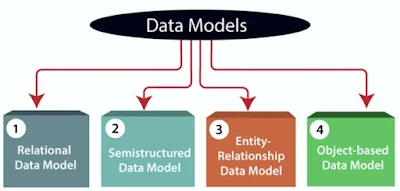Data Models
Ø Data Model is a logical structure of Database.
Ø Data Models are fundamental entities to introduce abstraction in a DBMS.
Ø It provides the conceptual tools for describing the design of a database at each
level of data abstraction.
Ø Data models define how data is connected to each other and how they are processed and stored inside the system.
Ø A Data Model in Database Management
System (DBMS) is the concept of tools that are developed to summarize the
description of the database.
Ø Data Models provide us with a transparent picture of data which helps us in creating an actual
database. It shows us from the design
of the data to its proper implementation of data.
Ø It describes the design of database to
reflect entities, attributes, relationship among data, constraints etc.
Ø It is the modelling of the data
description, data semantics, and consistency constraints of the data.
Ø Therefore, there are following four data
models used for understanding the structure of the database:
1) Relational
Data Model:
Ø This type of model designs the data in the form of rows and columns within a table.
Ø Thus, a relational model uses tables for representing data and in-between relationships.
Ø Tables will contain multiple columns with
unique names in the database
Ø Tables are also called relations.
Ø It is also known as record-based model
(Fixed format records of several data types). Each record type defines a fixed
no. of fields or attributes
Ø The relational data model is the widely
used model which is primarily used by commercial data processing applications.
Ø Most widely used data models
2) Entity-Relationship
Data Model:
Ø An E-R model is the logical representation of data as objects and relationships
among them.
Ø These objects are
known as entities, and
relationship is an association among these entities.
Ø It is widely used in database designing.
Ø An entity is a real-world thing or object
which is distinguishable from other objects
Ø It is basically a conceptual design (Pictorial
representation) of any database which is easy to design the view of data.
Components of ER Model:
o
Entity: An entity is referred to as a
real-world object. It can be a name, place, object, class, etc. These are
represented by a rectangle in an ER Diagram.
o
Attributes: An attribute can be defined as the
description of the entity. These are represented by Eclipse in an ER Diagram.
It can be Age, Roll Number, or Marks for a Student.
o
Relationship: Relationships are used to define
relations among different entities. Diamonds and Rhombus are used to show
Relationships.
3) Object-Based
Data Model:
Ø An extension of the ER model with notions
of functions, encapsulation, and object identity, inheritance etc.
Ø Object-Based Model = E-R Model + Object Oriented Features
Ø Suppose if our front end is designed
using OOP languages like C++, Java, C# etc then we need to have back end which
also support front end, in that case we are in the need of Object-Based Model.
Ø This model supports a rich type system
that includes structured and collection types.
Components of Object-oriented Data Model:
Ø Objects –
An object is an abstraction of a real-world entity or we can say it is an
instance of class. Objects encapsulates data and code into a single unit which
provide data abstraction by hiding the implementation details from the user.
For example: Instances of student, doctor, engineer in above figure.
Ø Attribute –
An attribute describes the properties of object. For example: Object is STUDENT
and its attribute are Roll no, Branch, Setmarks() in the Student class.
Ø Methods –
Method represents the behavior of an object. Basically, it represents the
real-world action. For example: Finding a STUDENT marks in above figure as
Setmarks().
Ø Class –
A class is a collection of similar objects with shared structure i.e.
attributes and behavior i.e. methods.
4)
Semi-Structured Data Model:
Ø This type of data model is different from
the other three data models.
Ø The semi-structured data model allows the
data specifications at places where the individual data items of the same type
may have different sets of attributes
Ø Two applications need to communicate with
each other, and if they want to use Database then we can go for Semi-structured
data model.
Ø The Extensible Markup Language, also
known as XML, is widely used for representing the semi-structured data.
<Note>
<From>
Online Smart Trainer</From>
<To>
All the students</To>
<Subject>
Lecture Notes </Subject>
<Body>
Thank you for visiting onlinesmarttrainer.blogspot.com. Good luck </Body>
</Note>





Data modes refer to the different states or representations of data, such as active, stored, or transmitted. These modes ge proton dictate how data is accessed, processed, and protected during its lifecycle.
ReplyDelete